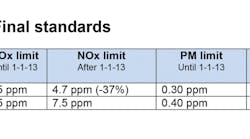New emission standards for transport refrigeration unit engines now in effect
Implementation of the U.S. EPA Tier 4 Final emission standards for non-road diesel engines in the less than 50 horsepower classification took effect on Jan. 1, 2013.
The standards cover transport refrigeration unit (TRU) engines, including those used in the 25 to 50 horsepower range historically used on refrigerated trailers, says Doug Lenz, director of product management and marketing for Thermo King, a manufacturer of temperature control systems for a variety of mobile applications and a brand of Ingersoll Rand. www.thermoking.com.
"The EPA regulations for greater than 25 but less than 50 horsepower TRU engines require reductions of about 90 percent in particulate matter (PM) and 37 percent in nitrogen oxide (NOx) emissions from the interim standards that have been in effect since 2008," he explains.
"In addition all TRU engines, regardless of horsepower, need to comply with new not-to-exceed (NTE) PM and NOx limits at elevations of 5,500 feet. Previous standards were based on emissions at sea level."
While the EPA regulations do not affect equipment that is already in service, fleets operating on California highways also must comply with current California Air Resources Board (CARB) regulations requiring that haulers replace or upgrade refrigeration unit diesel engines that are more than seven years old, points out Lenz. "The significant restrictions on PM that CARB rules require make it difficult for operators to comply without installing Level 3 Diesel Particulate Filters (DPFs) or using electric standby technologies and practices."
Using technologies similar to those used by tractor engine manufacturers to meet emission standards imposed over the last decade, original equipment manufacturers are improving TRU performance while also reducing the environmental footprint of TRU engines, he says. All manufacturers were expected to have their fully compliant products available for customer deliveries by the Jan. 1, 2013, implementation date.
The EPA regulations let manufacturers sell their existing inventories of equipment that meets the Tier 4 Interim standards during a short transition period.
"Some operators may choose to purchase these units, especially those that tend to turn over equipment frequently, says Lenz. "Operators with longer replacement cycles will usually find that being early adopters of new, more fuel-efficient technologies will provide the best return on investment over time."
As fleets develop their plans for the next few years, it is beneficial to discuss their requirements with original equipment manufacturers of TRUs or their authorized dealers, he advises.




